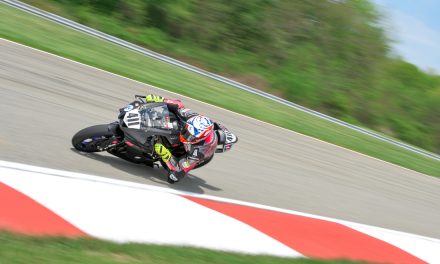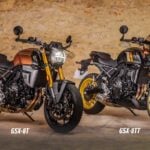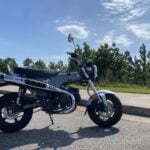How One Man’s Vision Literally Shaped Motorcycling
Sound design was once an under-appreciated aspect of success within the motorcycle realm. For such objects of desire that aim to stir heart and soul, nailing an appealing shape and silhouette was enough to make or break the British entrants of the 60s and 70s.
The story of the Triumph X75 depicts this vividly, and the involvement of one man, and the legacy he carried through to other two-wheeled designs, is one that deserves a brief retelling. Facing new competition from the attractively-priced and unexpectedly good-looking offerings from the likes of Honda, Yamaha, and Kawasaki, BSA found themselves in a sticky situation.
Their new inline-3 “Rocket 3” was under fire. Not only was it released too late to mount a convincing challenge to Honda’s feature-packed CB750, but it also lacked the design flair buyers yearned for. It was a similar story with Triumph’s cloned effort, the Trident. Even after several AMA-certified speed and endurance records were set, US sales were flat.
BSA/Triumph’s US team decided to take matters into their own hands. Unbeknownst to their British bosses, they commissioned fairing-guru, Craig Vetter, to develop a new design. Vetter, who had himself slowly built a reputation for his crisp and modern designs, was a breath of fresh air. The Rocket he was given was worked over with a radical redesign of many significant components. Most notable was the tank and seat base, joined in one flowing part. The forks were extended, while the reworked creation wore different wheels. Even the engine’s cooling fins were redesigned in a bid to make the bike look more powerful.
Many describe the Triumph X75 Hurricane as the world’s first “factory custom,” and those words tally with Vetter’s involvement in the project. It indeed was a customized bike offered by a manufacturer. Although not enough to make a convincing impact, the low sales numbers have translated into the Hurricane becoming a highly sought-after collectible today.
As for Craig Vetter, the Hurricane was just the start of his association with significantly customized bikes. After the Triumph, he turned his hand to racing. He soon became known for riding the now-dominant Japanese wave of motorcycles, until a significant injury sustained on his Yamaha RD350 led him to refocus on race bike sponsorship and design.
Based on a Kawasaki ZR1000, the Mystery Ship featured a full fairing that predated the mass incorporation of such bodywork on later sport bikes. Similar in appearance, the marketing material described the only difference between the Vetter Racing Bike and the Mystery Ship as a headlight and tread on the tires.
While extensive modifications to the frame were made—including a new box-section swingarm and laid-down shocks—the most striking element was the full-body fiberglass that genuinely lent itself to the Mystery Ship moniker.
But the economics were off: each bike cost $10,000, almost three times the price of a standard ZR1000, which, even then, wasn’t enough to break even on each unit. After yet another tragic event for Vetter, this time a crash in his ultralight aircraft, Craig turned his attention to wheelchair design. The Mystery Ship, which was originally planned for large-scale production, only ever saw ten units produced. But it, and Vetter’s, legacy remains very much intact, influencing modern day sport bike design to this day.




























Craig Vetter did not extend the forks. He submitted his design to BSA and they approved every single one of his suggestions along with the standard length forks. When he came over to the UK for the final design meeting, someone at BSA/Triumph had put 2″ slugs in the fork tubes. Vetter liked the look and it was kept. He told me this himself when he came over for the Triumph Bonneville’s 50th birthday rally.
Thanks for your information, Mark. I’d be happy for you to share your corrections with the original writers of this story, and curators at the Throttlestop museum-
info@throttlestop.com
Like the Craig Vetter story, but describing the T150 as ” Triumph’s cloned effort, the Trident” is bullshit. The Trident was no clone, it ran in a slghtly altered T120 Bonneville frame, and the triple-cylinder motor was pure Triumph, designed by Doug Hele, who in effect added an extra pot to the unit Tiger 100. The twin camshafts, the valve-gear, the push-rod tubes, the separate rocker boxes clearly show its motor’s DNA as inherited from the Edward Turner 1937 Speed Twin design. The BSA Rocket 3 engine was built in cases which inclined the motor forward by 15 degrees in a BSA twin down-tube frame, but all the internals were the same. I’ve rebuit several, and own one of each.
I’d be happy for you to share your insights with the original writers of the story, and curators at the museum-
info@throttlestop.com
Often the case that real-life info comes from, “there” commentators and is great for the real backstory and learning, Cheers Mark Hickson, Rex Knight
Was at “The Art of the Motorcycle” Guggenheim with two friends and looking at the Hurricane displayed above head level. Between the three of us there was over 100 years deep experience with motorcycles and combined we had owned over 150 motorcycles. In fact I had owned a Hurricane and sold it to one of the others who still owns it. We were side-by-side looking at the bike and discussing an an issue with the lower triple clamps cracking. I’m talking out my butt about it when a voice behind us said “Do you want to know what really happened?” and I’m thinking “What New York clown thinks he knows more than us?” and I turn around and Guess Who is standing there….I can’t even recall what he said from the shock and embarrassment of the situation. ..
Cool story, Lawrence, thanks for sharing! I’m guessing the legend himself, Vetter!